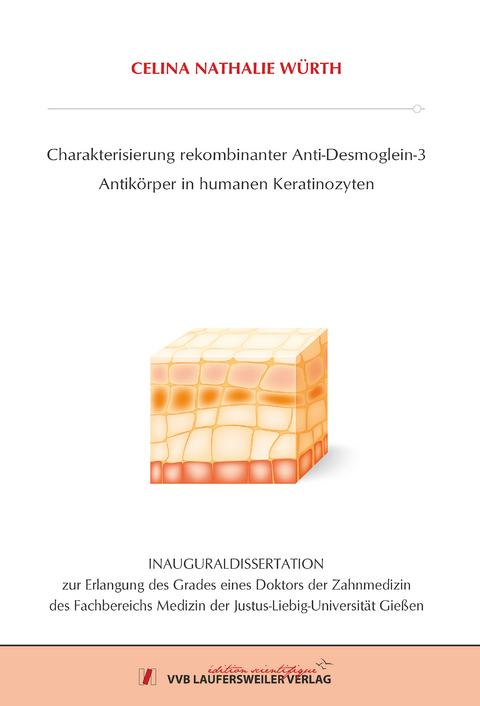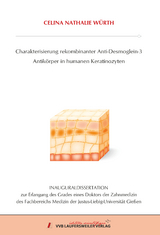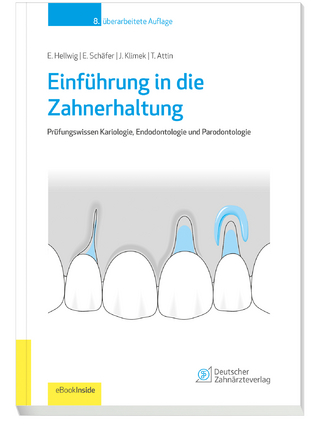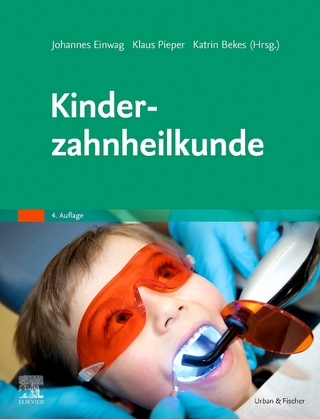Charakterisierung rekombinanter Anti-Desmoglein-3 Antikörper in humanen Keratinozyten
Seiten
2023
VVB Laufersweiler Verlag
978-3-8359-7100-4 (ISBN)
VVB Laufersweiler Verlag
978-3-8359-7100-4 (ISBN)
- Keine Verlagsinformationen verfügbar
- Artikel merken
Die Erkrankung Pemphigus vulgaris ist eine Autoimmundermatose, bei der IgG-Typ Autoantikörper zu einer Blasenbildung in der Epidermis führen. Die Zielantigene der Autoantikörper stellen vor allem die desmosomalen Cadherine Dsg-1 und Dsg-3 der epidermalen Keratinozyten dar, woraufhin es zu einem desmosomalen Adhäsionsverlust mit resultierender Blasenbildung an der Haut und/oder den Schleimhäuten kommt. Es war bereits bekannt, dass die Inhibition der IgG-Autoantikörper-Bindung an den neonatalen Fc-Rezeptor (FcRn) zu einem reduzierten Recycling dieser pathogenen Antikörper führt, was die Halbwertszeit derer im Serum reduziert. Dieser Mechanismus stellt eine neue Option zur Behandlung von Pemphigus vulgaris dar.
Ein Ziel dieser Arbeit war es, Dsg-3-defiziente HaCaT-Zellen durch CRISPR/Cas9 Genom-Editierung herzustellen, um die Funktion von Dsg-3 in humanen Keratinozyten genauer zu analysieren. Es konnten jedoch keine Dsg-3-defizienten Zellen generiert werden, da einige Zellen das Wachstum einstellten und schlussendlich abstarben.
Ein weiteres Vorhaben dieser Arbeit war es, die Bedeutung des FcRn in humanen Keratinozyten zu erläutern, die mit rekombinanten Anti-Dsg-3 Antikörpern behandelt wurden. Da die, in der Forschung häufig verwendeten, murinen Anti-Dsg-3-Antikörper wie mAK23, nicht an den humanen FcRn binden können, wurden die rekombinanten Antikörper hAK23 IgG1 und h4B3 verwendet, da diese einen humanen Fc-Anteil besitzen. Für diese pathogenen Anti-Dsg-3 Antikörper konnte gezeigt werden, dass sie zu einer veränderten Dsg-3 Lokalisation an der Zellmembran, einer Degradation von Dsg-3 und einem Adhäsionsverlust im Keratinozytenmonolayer führen, was auf pathogene Veränderungen der Desmosomen hinweist. Die Aktivierung apoptotischer Proteine durch die rekombinanten Anti-Dsg-3-Antikörper konnte nicht nachgewiesen werden.
Das Präparat Efgartigimod stellt ein modifiziertes Fc-Fragment dar, welches bereits klinische Studien zu Pemphigus vulgaris, aber auch zu anderen IgG-vermittelten Autoimmunkrankheiten, durchläuft. In den Versuchen konnte gezeigt werden, dass die Blockierung der IgG-FcRn-Interaktion durch Efgartigimod zu einer verbesserten interzellulären Adhäsion des Keratinozytenmonolayers führt, wobei Efgartigimod die Degradation von Dsg-3, durch die Anti-Dsg-3-Antikörper, nicht aufhalten konnte und auch nicht zu einer Reorganisation von Dsg-3 an der Zellmembran führte. Erstaunlicherweise konnte ebenfalls nachgewiesen werden, dass nur der Anti-Dsg-3 Antikörper h4B3 zu einer FcRn-Degradation führte, die durch Efgartigimod aufgehalten werden konnte.
Diese Ergebnisse zeigen, dass der FcRn möglicherweise eine Rolle in der Pathogenese von Pemphigus spielt, und dieser Rezeptor möglicherweise in Keratinozyten eine andere Funktion hat, als das Recycling von IgGs. Somit könnte die Stabilisation der Keratinozytenadhäsion durch die Inhibition der IgG-FcRn-Interaktion eine neue Behandlungsoption für Pemphigus vulgaris darstellen. Pemphigus vulgaris is an autoimmune dermatosis, in which IgG-type autoantibodies lead to blistering in the epidermis. The target antigens of the autoantibodies are mainly the desmosomal cadherins, Dsg-1 and Dsg-3, in epidermal keratinocytes. The autoantibodies lead to a loss of desmosomal adhesion, with resulting blistering of the skin and/or mucous membranes. It has previously been shown that inhibition of IgG-type autoantibody binding to the neonatal Fc-receptor (FcRn) results in reduced recycling of these pathogenic antibodies, which reduces their half-life in the serum.
One aim of this work was to produce Dsg-3-deficient HaCaT cells by CRISPR/Cas9 genome editing, to further analyze the function of Dsg-3 in human keratinocytes. However, no Dsg-3-deficient cells could be generated, as the knockout cells did not proliferate and eventually died.
Another aim of this work was to elucidate the relevance of FcRn in human keratinocytes treated with recombinant anti-Dsg-3 antibodies. Instead of the murine anti-Dsg-3 antibodies, such as mAK23, that are frequently used in research but cannot bind to the human FcRn, the recombinant antibodies hAK23 IgG1 and h4B3 with a human Fc fragment were used. These pathogenic anti-Ds-g3 antibodies were shown to lead to altered Dsg-3 localization on the cell membrane, degradation of Dsg-3 and to a loss of adhesion in the keratinocyte-monolayer, indicating pathogenic changes in desmosomes. Activation of apoptotic proteins by recombinant anti-Dsg-3-antibodies was not detected.
The drug Efgartigimod represents a modified Fc fragment, and is already undergoing clinical trials for pemphigus vulgaris, but also for other IgG-mediated autoimmune diseases. In my experiments, it could be shown that blocking the IgG-FcRn interaction by Efgartigimod leads to an improved intercellular adhesion of the keratinocyte monolayer, whereas Efgartigimod could not prevent the degradation of Dsg-3 by anti-Dsg-3 antibodies and also did not lead to an improved organization of Dsg-3 at the cell membrane. Surprisingly, it was also demonstrated that only the anti-Dsg-3 antibody h4B3 led to FcRn degradation, which was not prevented by Efgartigimod.
The results of the present study indicate that FcRn may have a further function in keratinocytes, beyond its role in recycling of IgGs. Thus, stabilization of keratinocyte adhesion by inhibiting IgG-FcRn interaction may represent a new treatment option for pemphigus vulgaris.
Ein Ziel dieser Arbeit war es, Dsg-3-defiziente HaCaT-Zellen durch CRISPR/Cas9 Genom-Editierung herzustellen, um die Funktion von Dsg-3 in humanen Keratinozyten genauer zu analysieren. Es konnten jedoch keine Dsg-3-defizienten Zellen generiert werden, da einige Zellen das Wachstum einstellten und schlussendlich abstarben.
Ein weiteres Vorhaben dieser Arbeit war es, die Bedeutung des FcRn in humanen Keratinozyten zu erläutern, die mit rekombinanten Anti-Dsg-3 Antikörpern behandelt wurden. Da die, in der Forschung häufig verwendeten, murinen Anti-Dsg-3-Antikörper wie mAK23, nicht an den humanen FcRn binden können, wurden die rekombinanten Antikörper hAK23 IgG1 und h4B3 verwendet, da diese einen humanen Fc-Anteil besitzen. Für diese pathogenen Anti-Dsg-3 Antikörper konnte gezeigt werden, dass sie zu einer veränderten Dsg-3 Lokalisation an der Zellmembran, einer Degradation von Dsg-3 und einem Adhäsionsverlust im Keratinozytenmonolayer führen, was auf pathogene Veränderungen der Desmosomen hinweist. Die Aktivierung apoptotischer Proteine durch die rekombinanten Anti-Dsg-3-Antikörper konnte nicht nachgewiesen werden.
Das Präparat Efgartigimod stellt ein modifiziertes Fc-Fragment dar, welches bereits klinische Studien zu Pemphigus vulgaris, aber auch zu anderen IgG-vermittelten Autoimmunkrankheiten, durchläuft. In den Versuchen konnte gezeigt werden, dass die Blockierung der IgG-FcRn-Interaktion durch Efgartigimod zu einer verbesserten interzellulären Adhäsion des Keratinozytenmonolayers führt, wobei Efgartigimod die Degradation von Dsg-3, durch die Anti-Dsg-3-Antikörper, nicht aufhalten konnte und auch nicht zu einer Reorganisation von Dsg-3 an der Zellmembran führte. Erstaunlicherweise konnte ebenfalls nachgewiesen werden, dass nur der Anti-Dsg-3 Antikörper h4B3 zu einer FcRn-Degradation führte, die durch Efgartigimod aufgehalten werden konnte.
Diese Ergebnisse zeigen, dass der FcRn möglicherweise eine Rolle in der Pathogenese von Pemphigus spielt, und dieser Rezeptor möglicherweise in Keratinozyten eine andere Funktion hat, als das Recycling von IgGs. Somit könnte die Stabilisation der Keratinozytenadhäsion durch die Inhibition der IgG-FcRn-Interaktion eine neue Behandlungsoption für Pemphigus vulgaris darstellen. Pemphigus vulgaris is an autoimmune dermatosis, in which IgG-type autoantibodies lead to blistering in the epidermis. The target antigens of the autoantibodies are mainly the desmosomal cadherins, Dsg-1 and Dsg-3, in epidermal keratinocytes. The autoantibodies lead to a loss of desmosomal adhesion, with resulting blistering of the skin and/or mucous membranes. It has previously been shown that inhibition of IgG-type autoantibody binding to the neonatal Fc-receptor (FcRn) results in reduced recycling of these pathogenic antibodies, which reduces their half-life in the serum.
One aim of this work was to produce Dsg-3-deficient HaCaT cells by CRISPR/Cas9 genome editing, to further analyze the function of Dsg-3 in human keratinocytes. However, no Dsg-3-deficient cells could be generated, as the knockout cells did not proliferate and eventually died.
Another aim of this work was to elucidate the relevance of FcRn in human keratinocytes treated with recombinant anti-Dsg-3 antibodies. Instead of the murine anti-Dsg-3 antibodies, such as mAK23, that are frequently used in research but cannot bind to the human FcRn, the recombinant antibodies hAK23 IgG1 and h4B3 with a human Fc fragment were used. These pathogenic anti-Ds-g3 antibodies were shown to lead to altered Dsg-3 localization on the cell membrane, degradation of Dsg-3 and to a loss of adhesion in the keratinocyte-monolayer, indicating pathogenic changes in desmosomes. Activation of apoptotic proteins by recombinant anti-Dsg-3-antibodies was not detected.
The drug Efgartigimod represents a modified Fc fragment, and is already undergoing clinical trials for pemphigus vulgaris, but also for other IgG-mediated autoimmune diseases. In my experiments, it could be shown that blocking the IgG-FcRn interaction by Efgartigimod leads to an improved intercellular adhesion of the keratinocyte monolayer, whereas Efgartigimod could not prevent the degradation of Dsg-3 by anti-Dsg-3 antibodies and also did not lead to an improved organization of Dsg-3 at the cell membrane. Surprisingly, it was also demonstrated that only the anti-Dsg-3 antibody h4B3 led to FcRn degradation, which was not prevented by Efgartigimod.
The results of the present study indicate that FcRn may have a further function in keratinocytes, beyond its role in recycling of IgGs. Thus, stabilization of keratinocyte adhesion by inhibiting IgG-FcRn interaction may represent a new treatment option for pemphigus vulgaris.
| Erscheinungsdatum | 18.02.2023 |
|---|---|
| Reihe/Serie | Edition Scientifique |
| Verlagsort | Gießen |
| Sprache | deutsch |
| Maße | 148 x 215 mm |
| Gewicht | 180 g |
| Themenwelt | Medizin / Pharmazie ► Zahnmedizin ► Klinik und Praxis |
| Schlagworte | Anti-Dgs3-AK • Autoimmundermatose • Autoimmunerkrankung • Hauterkrankung • Keratinozyten • pemphigus vulgaris • Rekombinant |
| ISBN-10 | 3-8359-7100-X / 383597100X |
| ISBN-13 | 978-3-8359-7100-4 / 9783835971004 |
| Zustand | Neuware |
| Informationen gemäß Produktsicherheitsverordnung (GPSR) | |
| Haben Sie eine Frage zum Produkt? |
Mehr entdecken
aus dem Bereich
aus dem Bereich
Prüfungswissen Kariologie, Endodontologie und Parodontologie
Buch (2023)
Deutscher Ärzteverlag
69,99 €




